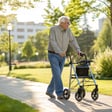Staying fit after 50 doesn't have to mean high-intensity workouts that leave your joints aching for days. The fitness landscape is changing for the better.
The Rise of Low-Impact Fitness Among Seniors
The fitness industry has witnessed a significant shift in recent years. Baby boomers—those born between 1946 and 1964—are increasingly gravitating toward exercise routines that prioritize joint health while still delivering cardiovascular benefits. This trend isn't surprising when you consider that approximately 54 million Americans over 50 experience some form of joint pain or arthritis, according to recent health surveys.
"You're never too old to start exercising and pursuing a healthier lifestyle," notes the Greater Wichita YMCA's active older adults program guide. This philosophy has fueled the development of specialized fitness programs nationwide that cater specifically to the unique needs of the 50+ demographic.
Low-impact cardio has become the cornerstone of these programs, offering a perfect balance between effective workouts and joint protection. But what exactly makes these exercises so appealing to active boomers?
Joint-Friendly Cardio: The Perfect Balance
Joint-friendly cardio exercises are those that raise your heart rate without putting excessive stress on your knees, hips, and other vulnerable joints. Unlike high-impact activities such as running or jumping, low-impact fitness options minimize the force exerted on the body while still providing substantial health benefits.
The YMCA of Greater St. Petersburg offers more than 150 group exercise classes weekly, with numerous options specifically designed as safe exercise for seniors. These classes typically incorporate movements that keep one foot on the ground at all times, reducing jarring impacts while maintaining cardiovascular intensity.
Some popular joint-friendly cardio options include:
- Water aerobics (the buoyancy of water reduces joint stress by up to 90%)
- Stationary cycling (provides cardiovascular benefits without weight-bearing stress)
- Elliptical training (mimics running motion without impact)
- Walking (particularly on softer surfaces like tracks or treadmills)
- Rowing (engages multiple muscle groups with minimal joint strain)
I tried water aerobics last month after my knee started acting up during my regular walks. The difference was immediate—I got my heart rate up without any pain afterward. Might be worth checking if your local community center offers these classes.
Best Cardio Exercises for the Over 50 Crowd
When it comes to over 50 workouts, not all cardio is created equal. The most effective routines combine moderate intensity with movements that respect age-related changes in joint integrity and muscle mass.
SilverSneakers, a fitness program included with many Medicare plans, has pioneered specialized classes that "alternate upper-body strength work with low-impact cardio to maximize fitness benefits." This approach ensures participants receive comprehensive conditioning without overexertion.
Dr. Maria Gonzalez, a sports medicine specialist at University Medical Center, recommends that seniors aim for about 150 minutes of moderate-intensity cardio each week. "The key is consistency rather than intensity," she explains. "Regular, moderate exercise delivers better long-term results than occasional intense workouts, especially for older adults."
Gentle Workouts That Pack a Punch
Don't let the word "gentle" fool you—these workouts can still be highly effective. Low-impact doesn't necessarily mean low-intensity. Many active boomers find that they can actually exercise longer and more frequently with joint-friendly approaches, ultimately burning more calories and improving cardiovascular health more consistently.
According to a study published in the journal Medicine & Science in Sports & Exercise, adults who engaged in regular low-intensity activity showed significant improvements in metabolic health markers, including lower blood pressure and improved glucose tolerance. The research suggests that the cumulative effect of consistent, moderate exercise may actually outweigh short bursts of high-intensity training for long-term health outcomes.
How Cardio for Seniors Differs from Younger Adults
The physiological changes that occur with aging necessitate a different approach to cardiovascular exercise. After 50, the body typically experiences:
- Decreased muscle mass and strength
- Reduced joint cartilage and flexibility
- Lower maximum heart rate
- Longer recovery times
- Decreased bone density
These changes don't mean seniors should avoid exercise—quite the opposite. They simply require adaptations to traditional workout approaches.
"For my older clients, I focus on building cardiovascular endurance through steady-state, low-impact cardio rather than interval training," notes fitness trainer Robert Jenkins. "We might do 30 minutes on a recumbent bike rather than 20 minutes of high-intensity intervals. The results are excellent, and they don't dread coming back for their next session."
Why Are More Seniors Embracing Low-Impact Cardio?
The growing popularity of low-impact cardio among active boomers stems from several factors:
- Injury Prevention: Low-impact exercises significantly reduce the risk of falls and injuries during workouts.
- Accessibility: Many low-impact options require minimal equipment and can be performed at home or in community settings.
- Social Connections: Group classes like those offered by the YMCA provide valuable social interaction alongside physical benefits.
- Stress Reduction: According to research published in PMC (PubMed Central), regular low-intensity activity helps mitigate the effects of stress, which is particularly beneficial for older adults.
- Sustainable Fitness: Unlike more extreme exercise regimens, low-impact routines can be maintained for decades, supporting lifelong fitness.
The UCI Center for Healthspan Sciences notes that gentle movement practices like beginner yoga can also complement low-impact cardio, helping with weight management while improving balance and flexibility—critical factors for maintaining independence as we age.
Can Low-Impact Cardio Help With Weight Management?
A common question among seniors considering fitness options is whether low-impact exercise can effectively support weight management goals. The answer is a resounding yes.
While high-intensity workouts might burn more calories per minute, low-impact cardio sessions can often be sustained for longer periods and performed more frequently. This consistency creates a greater cumulative calorie burn and metabolic benefit.
Additionally, gentle workouts that elevate the heart rate moderately help preserve muscle mass—a critical factor in maintaining a healthy metabolism as we age. Since muscle naturally decreases about 3-8% per decade after 30, exercises that combine cardio with light resistance are particularly valuable for senior fitness.
The key is finding activities you enjoy enough to stick with. Walking with friends three times weekly will yield better results than an intense workout program abandoned after two weeks because of pain or burnout.
Disclaimer
This article is for informational purposes only and not a substitute for professional medical advice. Before starting any new exercise program, especially if you have existing health conditions, consult with your healthcare provider to ensure the activities are appropriate for your specific situation.
Remember: The best exercise is the one you'll actually do consistently. For many active boomers, low-impact cardio provides the perfect balance of effectiveness, enjoyment, and sustainability.
Tags

About Rafael Mendoza the Author
Rafael Mendoza, an avid cyclist and urban planner, has dedicated over a decade to mapping out safe and efficient cycling routes in bustling city environments. His extensive research and hands-on experience make him a leading expert in transforming urban landscapes into cyclist-friendly spaces.
Recommended Articles
4 Everyday Drinks Being Studied for Circulation Support
Explore 4 everyday drinks that may enhance circulation, including herbal teas, coffee, red wine, and beetroot juice. Discover their health benefits.
Why More Seniors Are Considering Compact Mobility Tech
Explore how compact mobility tech enhances independence and quality of life for seniors, making daily activities more accessible and enjoyable.
Why More Seniors Are Replacing Walkers With This Sleek Device
Discover why seniors are opting for sleek mobility devices over traditional walkers, enhancing their independence with style and functionality.
2025 Cadillac CT4 Combines Performance With Refined Luxury
Discover the 2025 Cadillac CT4, where thrilling performance meets luxury, featuring advanced safety, elegant interiors and powerful engine options.
2025 Lexus RX Keeps the Luxury SUV Crown With Smarter Features
The 2025 Lexus RX redefines luxury SUVs with advanced tech, safety features, and a focus on comfort for an unparalleled driving experience.




